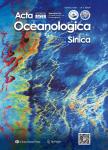Seasonal variability of the isopycnal surface circulation in the South China Sea derived from a variable-grid global ocean circulation model
Seasonal variability of the isopycnal surface circulation in the South China Sea derived from a variable-grid global ocean circulation model作者机构:First Institute of OceanographyState Oceanic Administration Laboratory for Regional Oceanography and Numerical Modeling Qingdao National Laboratory for Marine Science and Technology Key Lab of Marine Science and Numerical Modeling State Oceanic Administration
出 版 物:《Acta Oceanologica Sinica》 (海洋学报(英文版))
年 卷 期:2016年第35卷第1期
页 面:11-20页
核心收录:
学科分类:0710[理学-生物学] 07[理学] 0908[农学-水产] 0707[理学-海洋科学]
基 金:The National High Technology Research and Development Program(863 Program)of China under contract No.2013AA09A506 the National Natural Science Foundation of China-Shandong Joint Fund for Marine Science Research Centers under contract No.U1406404 the National Basic Research Program(973 Program)of China under contract No.2011CB956000 the National Natural Science Foundation of China under contract No.40476016
主 题:South China Sea isopycnal surface circulation ocean general circulation model Luzon Strait transport
摘 要:In this study, we develop a variable-grid global ocean general circulation model (OGCM) with a fine grid (1/6)° covering the area from 20°S-50°N and from 99°-150°E, and use the model to investigate the isopycnal surface circulation in the South China Sea (SCS). The simulated results show four layer structures in vertical: the surface and subsurface circulation of the SCS are characterized by the monsoon driven circulation, with basin-scaled cyclonic gyre in winter and anti-cyclonic gyre in summer. The intermediate layer circulation is opposite to the upper layer, showing anti-cyclonic gyre in winter but cyclonic gyre in summer. The circulation in the deep layer is much weaker in spring and summer, with the maximum velocity speed below 0.6 cm/s. In fall and winter, the SCS deep layer circulation shows strong east boundary current along the west coast of Philippine with the velocity speed at 1.5 m/s, which flows southward in fall and northward in winter. The results have also revealed a fourlayer vertical structure of water exchange through the Luzon Strait. The dynamics of the intermediate and deep circulation are attributed to the monsoon driving and the Luzon Strait transport forcing.



